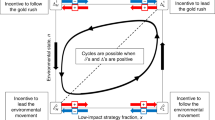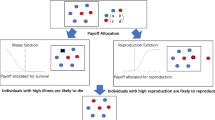Summary
Since the fitness of each individual organism in a biological community may be affected by the strategies of all other individuals in the community, the essential element of a ‘game’ exists. This game is an evolutionary game where the individual organisms (players) inherit their strategies from continuous play of the game through time. Here, the strategies are assumed to be constants associated with certain adaptive parameters (such as sunlight conversion efficiency for plants or body length in animals) in a set of differential equations which describe the population dynamics of the community. By means of natural selection, these parameters will evolve to a set of strategy values that natural selection, by itself, can no longer modify, i.e. an evolutionarily stable strategy (ESS). For a given class of models, it is possible to predict the outcome of this evolutionary process by determining ESSs using an ESS maximum principle. However, heretofore, the proof of this principle has been based on a limited set of conditions. Herein, we generalize the proof by removing certain restrictions and use instead the concept of an ecological stable equilibrium (ESE). Individuals in a biological community will be at an ESE if fixing the strategies used by the individuals results in stable population densities subject to perturbations in those densities. We present both necessary and sufficient conditions for an ESE to exist and then use the ESE concept to provide a very simple proof of the ESS maximum principle (which is a necessary condition for an ESS). A simple example is used to illustrate the difference between a strategy that maximizes fitness and one that satisfies the ESS maximum principle. In general they are different. We also look for ESEs in Lotka—Volterra competition and use the maximum principle to determine when an ESE will be an ESS. Finally, we examine the applicability of these ideas to matrix games.
Similar content being viewed by others
References
Apostol, T.M. (1974)Mathematical Analysis. Addison-Wesley, Reading, MA.
Axelrod, R. and Hamilton, W.D. (1981) The evolution of cooperation.Science 211, 1390–6.
Brown, J.S. and Vincent, T.L. (1986) Predator—prey coevolution as an evolutionary game. InApplications of Control Theory in Ecology (Y. Cohen, ed.), pp. 80–97. Springer-Verlag, Berlin.
Brown, J.S. and Vincent, T.L. (1987) A theory for the evolutionary game.Theor. Pop. Biol. 31, 140–66.
Brown, J.S. and Vincent, T.L. (1992) Organization of predator—prey communities as an evolutionary game.Evolution 46, 1269–83.
Case, T.J. (1982) Coevolution in resource-limited competition communities.Theor. Pop. Biol. 21, 69–91.
Friedman, D. (1991) Evolutionary games in economics.Econometrica 211, 637–66.
Goh, B.S. (1980)Management and Analysis of Biological Populations. Elsevier, Amsterdam.
Hines, W.G.S. (1987) Evolutionary stable strategies: a review of basic theory.Theor. Pop. Biol. 31, 195–272.
May, R.M. (1973)Stability and Complexity in Model Ecosystems. Princeton University Press, Princeton, NJ.
May, R.M. (1976) Simple mathematical models with very complicated dynamics.Nature 266, 459–67.
Maynard Smith, J. (1982)Evolution and the Theory of Games. Cambridge University Press, Cambridge.
Riechert, S.E. and Hammerstein, P. (1983) Game theory in the ecological context.Ann. Rev. Ecol. Syst. 14, 377–409.
Roberts, A. (1974) The stability of feasible random systems.Nature 250, 607–8.
Roughgarden, J. (1983) The theory of coevolution. InCoevolution (D.J. Futuyama and M. Slatkin, eds), pp. 383–403. Sinauer, Sunderland, MA.
Rummel, J.D. and Roughgarden, J. (1983) Some differences between invasion-structured and coevolutionstructured competitive communities: a preliminary theoretical analysis.Oikos 41, 477–86.
Vincent, T.L. (1985) Evolutionary games.J. Optimizat. Theory Appl. 46(4), 605–12.
Vincent, T.L. and Brown, J.S. (1984) Stability in an evolutionary game.Theor. Pop. Biol. 26, 408–27.
Vincent, T.L. and Brown, J.S. (1987) An evolutionary response to harvesting. InModeling and Management of Resources Under Uncertainty (T.L. Vincent, Y. Cohen, W.J. Grantham, G.P. Kirkwood and J.M. Skowronski, eds), pp. 80–97. Springer-Verlag, Heidelberg.
Vincent, T.L. and Brown, J.S. (1988) The evolution of ESS theory.Ann. Rev. Ecol. Syst. 19, 423–43.
Vincent, T.L. and Brown, J.S. (1989) The evolutionary response to a changing environment.Appl. Math. Comput. 32, 185–206.
Vincent, T.L. and Fisher, M.E. (1988) Evolutionarily stable strategies in differential and difference equation models.Evol. Ecol. 2, 321–37.
Vincent, T.L, Cohen, Y. and Brown, J.S. (1993) Evolution via strategy dynamics.Theor. Pop. Biol. 44, 149–76.
Zeeman, E.C. (1980) Population dynamics from game theory. InGlobal Theory of Dynamical Systems (Z. Nitecki and C. Robinson, eds), pp. 471–97. Springer-Verlag, Berlin.
Author information
Authors and Affiliations
Rights and permissions
About this article
Cite this article
Vincent, T.L., Van, M.V. & Goh, B.S. Ecological stability, evolutionary stability and the ESS maximum principle. Evol Ecol 10, 567–591 (1996). https://doi.org/10.1007/BF01237708
Issue Date:
DOI: https://doi.org/10.1007/BF01237708




